Nội dung bài viết
Electricity is an essential source of energy in modern life but can also cause dangerous incidents if not operated and used properly. To avoid unfortunate accidents related to electricity, users need to clearly understand the safe distances according to each voltage level. Learn about the electrical safety distance prescribed by the Vietnam Electricity Law in the following article by KTH ELECTRIC.
Concepts of electrical safety distance
According to the general definition, electrical safety distance is the minimum distance that people or objects need to maintain from power lines or live equipment to ensure safety and avoid the risk of electric discharge and electric shock. This distance depends on the voltage level and may vary depending on the individual regulations of each country and region.
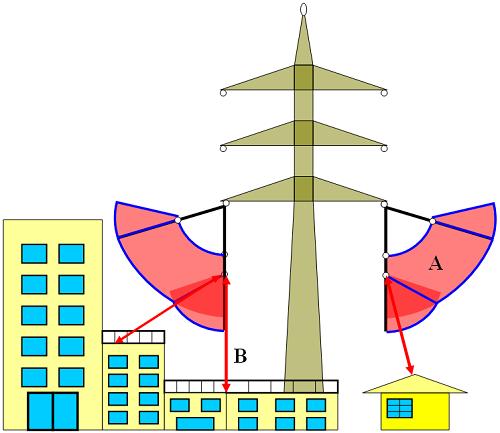
In Vietnam, electrical safety distance is determined according to voltage levels prescribed by Circular 39/2015/TT-BCT as follows:
- Low voltage is the nominal voltage level up to 01kV
- Medium voltage is the nominal voltage level from 01kV to 35kV
- High voltage is the nominal voltage level above 35kV to 220kV
- Ultra high voltage is a nominal voltage level above 220kV or 500kV
In addition to voltage level, factors such as weather conditions (rain, storms…), humidity and presence of conductive objects can also affect this safe distance.
Besides the term grid safety distance, a number of related terms are regulated including:
- Discharge safety distance: Is the minimum distance from the electric conductor to the nearest point of equipment, tools, and working vehicles in the high-voltage grid safety protection corridor – According to Clause 4, Article 51 of the Electricity Law.
- Discharge safety distance: Also the minimum distance from the electric conductor when the wire is in its maximum sag state to the highest point of the protected object – According to Clause 5, Clause 6 and Clause 7, Article 51 of the Electricity Law.
- Power grid safety corridor: Is an air circulation space in width, length and height running along a power transmission line or surrounding a power station – According to Vietnam Construction Code QCXDVN 01:2008/BXD.
Regulation of electrical safety distance according to the Electricity Law
The power grid safety corridor in our country is stipulated in the Electricity Law No. 28/2004/QH11 issued by the National Assembly and Decree No. 14/2014/ND-CP detailing the implementation of the Electricity Law on electrical safety issued by the Government. The specific regulations are as follows:
Minimum safe distance according to voltage level
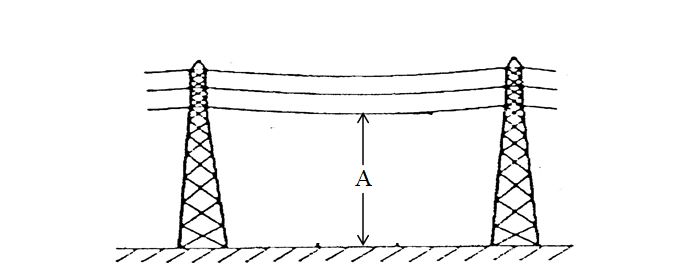
When there is no temporary barrier, the electrical safety distance is not less than specified in the table:
| Voltage level | Minimum electrical safety distance |
| Low voltage electricity | 0.3 m |
| Voltage from 1kV to 15kV | 0.7 m |
| Voltage from 15kV to 35kV | 1 m |
| Voltage from 35kV to 110kV | 1.5 m |
| Voltage from 110kV to 220kV | 2.5 m |
| Voltage from 220kV to 500kV | 4.5 m |
When there is a temporary barrier, the safe distance from the barrier to the energized part is not less than specified in the table:
| Voltage level | Minimum electrical safety distance |
| Voltage from 1kV to 15kV | 0.35 m |
| Voltage from 15kV to 35kV | 0.60 m |
| Voltage from 35kV to 110kV | 1.50 m |
| Voltage from 110kV to 220kV | 2.50 m |
| Voltage from 220kV to 500kV | 4.50 m |
Safe discharge distance according to voltage level
According to Clause 1, Article 51 of the Electricity Law:
| Voltage | Up to 22kV | 35kV | 110kV | 220kV | ||
| Wrapped wire | Bare wire | Wrapped wire | Bare wire | Bare wire | Bare wire | |
| Safe discharge distance | 1.0 m | 2.0 m | 1.5 m | 3.0 m | 4.0 m | 6.0 m |
According to Clause 4, Article 51 of the Electricity Law:
| Voltage | Up to 22kV | 35kV | 110kV | 220kV | 500kV |
| Safe discharge distance | 4.0 m | 4.0 m | 6.0 m | 6.0 m | 8.0 m |
According to Clause 5, Clause 6 and Clause 7, Article 51 of the Electricity Law:
| Voltage
Discharge safety interval |
Up to 35kV | 110kV | 220kV | 500kV |
| To the highest point (4.5 m) of road vehicles | 2.5 m | 2.5 m | 3.5 m | 5.5 m |
| To the highest point (4.5 m) of a vehicle or railway traffic structure or to the highest point (7.5 m) of an electric railway vehicle or traffic structure | 3.0 m | 3.0 m | 4.0 m | 7.5 m |
| To the clearance height according to the technical level of the inland waterway | 1.5 m | 2.0 m | 3.0 m | 4.5 m |
High voltage electrical safety distance
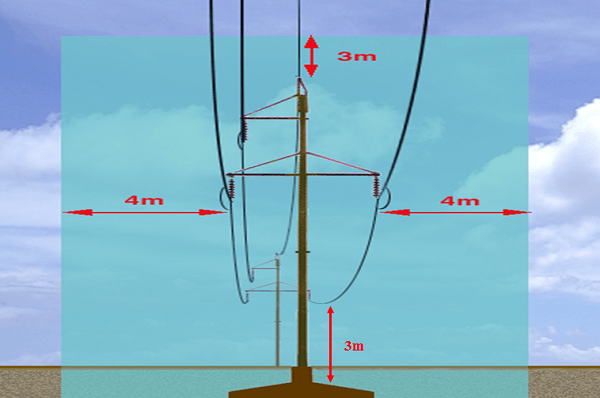
In Article 9 of Decree 14/2014/ND-CP amended by Points a, b, c Clause 6 Article 1 Decree 51/2020/ND-CP regulates the construction and renovation of overhead high-voltage power lines passing over houses and buildings with people living and working inside… as follows:
- Columns must be steel or reinforced concrete columns; The safety factor of columns, beams, and column foundations is not less than 1.2.
- In a column space, electric conductors and lightning arresters are not allowed to have joints, except for electric conductors with a cross-section of 240mm2 or more, which allows one connection per wire. The safety factor of electric conductors and lightning arresters is not less than 2.5.
- Insulators must be arranged in pairs of the same type and technical characteristics. Electric conductors and lightning arresters, if connected on hanging insulators, must use fixed support locks. The safety factor of insulation and accessories must meet standards according to current regulations.
- The underground cable section connected to the overhead power line from the ground up to a height of two meters must be placed in a protective pipe.
- The distance from the lowest point of the electric conductor in the state of maximum deflection to the ground is not less than specified in the table:
| Voltage | Up to 35kV | 110kV | 220kV |
| Distance | 14 m | 15 m | 18 m |
Conditions for houses and buildings with people living and working inside to exist within the safety protection corridor of overhead high-voltage electrical lines up to 220kV
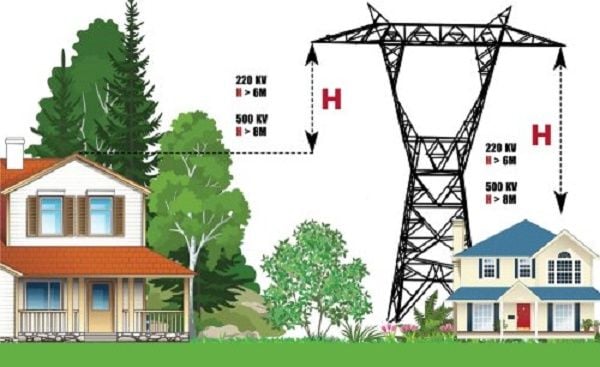
Article 13 of Decree 14/2014/ND-CP (amended by Points a, b and c, Clause 9, Article 1 of Decree 51/2020/ND-CP) stipulates that houses and construction works can exist within the safety protection corridor of overhead power lines with voltage up to 220kV if they meet all the following conditions:
- Roofs and walls must be made of non-flammable materials.
- Do not obstruct access for inspection, maintenance, or replacement of line parts.
- The electric field intensity is less than 5 kV/m at any point outside the house 01 meter above the ground and less than or equal to 1 kV/m at any point inside the house 01 meter above the ground.
- The distance from any part of the house or structure to the nearest electric wire when the wire is in the state of maximum deflection is not less than specified in the table:
| Voltage | Up to 35kV | 110kV | 220kV |
| Distance | 3.0 m | 4.0 m | 6.0 m |
Safe distance to protect power stations
For power stations without surrounding fences, the protection corridor is limited by the space surrounding the power station with the distance to the nearest energized part of the station according to regulations:
| Voltage | From 1kV to 22kV | 35kV |
| Distance | 2.0 m | 3.0 m |
For power stations surrounded by fixed fences, the corridor is limited to the outermost point of the foundation, protective embankment or fence. The height of the corridor is calculated from the bottom of the deepest foundation of the building to the highest point of the power station plus the safe discharge distance according to the voltage level:
| Voltage | From 1kV to 35kV | 110kV | 220kV | 500kV |
| Distance | 2.0 m | 3.0 m | 4.0 m | 6.0 m |
Trees inside and outside the corridor protect the safety of overhead power lines
Article 12 of Decree 14/2014/ND regulates tree spacing inside and outside the safety protection corridor of overhead power lines as follows:
For trees in the line safety protection corridor
For power lines with voltage up to 35kV in cities, towns, and townships, the distance from any point of the tree to the power line in the state of maximum sag is not less than the specified distance:
| Voltage | Up to 35kV | |
| Kpanic | Wrapped wire | Bare wire |
| 0.7 m | 1.5 m | |
For lines with voltage from 110kV to 500kV:
- Trees must not be higher than the lowest conductor, except in special cases where technical measures must be taken to ensure safety and approved by the People’s Committee of the province or centrally run city (Provincial People’s Committee).
- The distance from any point of the tree to the wire when the wire is in its maximum sag state is not less than the distance specified in the table:
| Voltage | 110kV | 220kV | 500kV |
| Distance | Bare wire | ||
| 2.0 m | 3.0 m | 4.5 m | |
For trees outside the line safety protection corridor and outside cities, towns, and townships: The distance from any part of the tree when it falls to any part of the line is not less than the specified distance:
| Voltage | Up to 35kV | 110kV | 220kV | 500kV | |
| Distance | Wrapped wire | Bare wire | Bare wire | ||
| 0.7 m | 2.0 m | 3.0 m | 4.0 m | 6.0 m | |
For trees outside line safety protection corridors and outside cities, towns and towns
The distance from any part of the tree when it falls to any part of the line is not less than the distance specified in the table:
| Voltage | Up to 35kV | 110 and 220kV | 500kV |
| Distance | 0.7 m | 1.0 m | 2.0 m |
Note: Rice, crops and trees can only be planted at least 0.5 m from the edge of the electric pole or anchor foundation.
Prohibited acts to ensure the safety of the power grid corridor
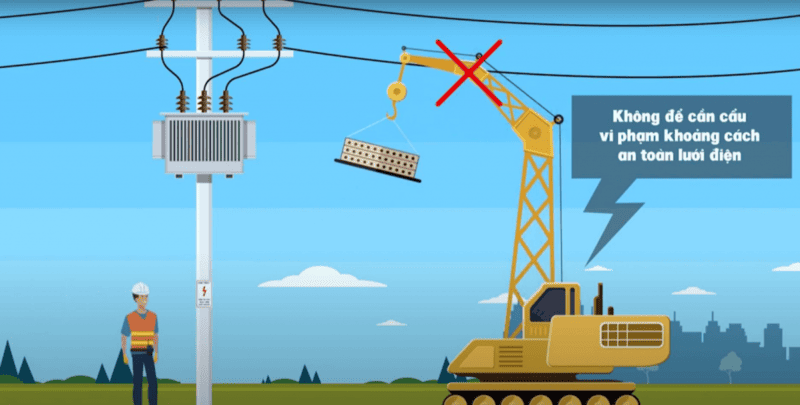
Article 4 of Decree 14/2014/ND-CP stipulates prohibited acts to ensure electrical safety corridors including:
- Theft or removal of anchor wires, ground wires, and equipment of the power grid; Climb on electric poles, enter power stations or electrical safety protection areas when not on duty.
- Using the high voltage grid project for other purposes without agreement with the high voltage grid project management unit.
- Flying kites or flying objects near high-voltage power grid projects can potentially cause power grid problems.
- Install the receiving and transmitting antenna; clothesline; scaffold; Signs, advertising light boxes and other items in locations where when they fall or fall, they can collide with high-voltage power grids.
- Planting trees or leaving trees violates the safe distance from overhead power lines and power stations.
- Shoot birds that perch on power lines or power stations or toss or throw any object onto power lines or power stations.
- Excavation causes subsidence of high-voltage power grids and power stations.
- Filling soil, stacking materials, equipment or dumping waste violates safe distance.
- Use electric poles and power stations to build houses, tents, shops, tie up cattle or use for other purposes.
- Blasting, opening mines; stacking or containing flammable and explosive substances and chemicals capable of causing corrosion or damage to parts of the power grid.
- Burning slash and burn fields, using construction equipment that causes shock or can cause damage or incidents to power grids, power stations, and power plants.
- Control aircraft whose distance to the nearest part of the high-voltage power grid project is less than 100 m, except for cases where the aircraft is responsible for managing, maintaining, and repairing power lines as permitted by regulations.
- Letting trees fall onto power lines when pruning trees or taking advantage of the protection and repair of high-voltage power grids to cut down trees.
- Other acts violating regulations on safety protection of high-voltage power grid projects.
Question about electrical safety distance
Question 1: How does the electrical safety distance change with voltage level?
Reply: The electrical safety distance will increase proportionally to the voltage level of the line or electrical equipment. For example, the minimum safe distance for voltages below 1kV might be 1.5m, while for 220kV this distance is 2.5m.
Question 2: Indicate the safe distance of the 22kV power grid?
Reply: The 22kV voltage belongs to the medium voltage grid with a minimum safe distance of voltage lines of 1.5m.
In addition, according to voltage level, safe discharge distance is:
- For bare wire: 2.0 m.
- For coated wire: 1.0 m.
Safe distance from the conductor to the nearest point of equipment, tools, and working means: 4.0m.
Safety protection corridor for overhead power lines:
- For bare wire: 2.0 m.
- For coated wire: 1.0 m.
Question 3: What is the safe distance between 110kV, 220kV and 500kV power grids?
Reply: The minimum safe distance of the above power grids are:
- 110kV: 1.5m
- 220kV: 2.5m
- 500kV: 4.5m
To learn other knowledge related to electrical system safety, please visit: https://btb-electric.com/vi/tin-tuc/kien-thuc-nganh/kien-thuc-he-thong-dien/


Nội dung được phát triển bởi đội ngũ truonglehongphong.edu.vn với mục đích chia sẻ và tăng trải nghiệm khách hàng. Mọi ý kiến đóng góp xin vui lòng liên hệ tổng đài chăm sóc: 1900 0000 hoặc email: hotro@truonglehongphong.edu.vn